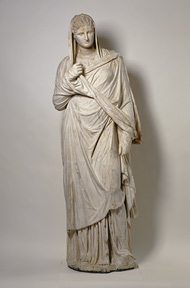The Herculaneum Women
|
The first sculptures discovered at Herculaneum, the three draped statues are also among the best preserved of all the sculptures found at the site. The Herculaneum Women are Roman versions of sculptural types deriving from Greek art. The two Herculaneum Women in this exhibition have idealized facial features and wear elegant, enveloping drapery. They share the same distinctive hairstyle, the so-called melon coiffure, which became fashionable in Greece after 350 B.C., when the models for the Herculaneum Women were created.
The third Herculaneum Woman, which is not on view in this exhibition, was missing its head when it was found. Her portrait head, probably with individualized features, was carved separately for insertion into the neck cavity. Who Are the Herculaneum Women? Whom did the original Greek models for these statues represent? They may have been goddesses or muses, although the sculptures lack any attributes that link them to characters from mythology. More likely they were portraits of priestesses, poets, or other eminent Greek women. The Roman figures from Herculaneum are equally difficult to identify, though their theater setting provides a clue. In Roman cities, theaters were a common place for the display of honorific statues of patrons and benefactors of the community. The Herculaneum Women may thus have represented members of the local elite. The Herculaneum Women in Ancient Art The majority of the figures are combined with individualized portraits. The J. Paul Getty Museum's collection alone contains four of these sculptures, including a monumental portrait of the Roman empress Faustina the Elder with the body of the Large Herculaneum Woman. |

